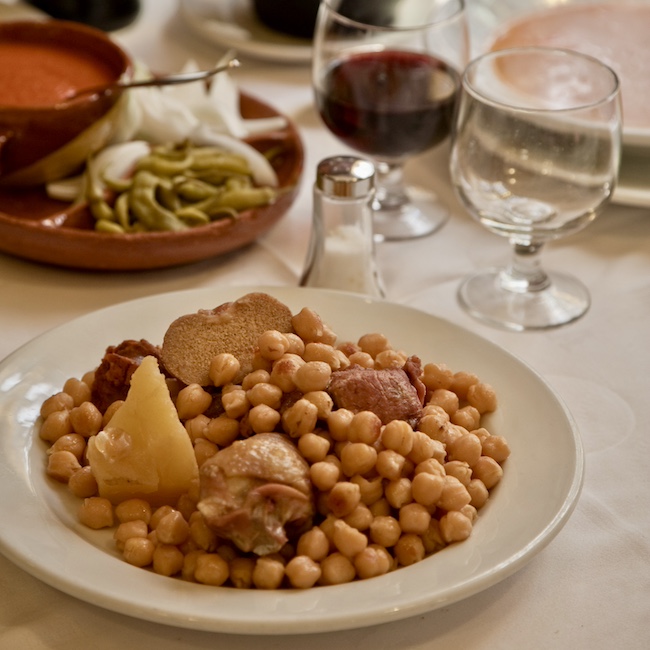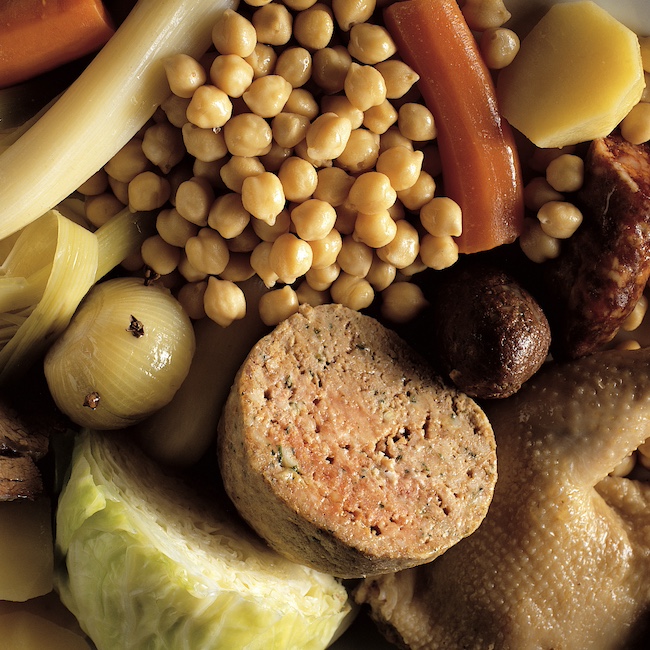.png.transform/rendition-xs/image_image%20(1).png)
Cocido Madrileño: A Hearty Celebration Every February 27
This is Madrid’s iconic stew, a legendary recipe made with top-quality ingredients
Every February 27, food lovers in Madrid and beyond gather to celebrate Cocido Madrileño, the region’s most emblematic dish. This hearty stew, deeply rooted in Spanish culinary tradition, showcases a slow-cooked symphony of flavors and ingredients.
Cocido madrileño is a three-course delight, typically enjoyed in vuelcos (stages): first comes the rich broth with fine noodles, followed by chickpeas accompanied by vegetables such as cabbage, potatoes, and carrots. Finally, a robust selection of meats, including chorizo, morcilla (blood sausage, not the rice one from Burgos), and tender beef cuts, rounds out the meal. Each element plays a vital role in this comforting dish, with certain ingredients standing out for their certified quality. According to the recipe, some ingredients may vary, but the structure of the dish remains the same.

A Slow-Cooked Dish with Top-Quality Ingredients
The heart of cocido madrileño is undoubtedly the broth—a blend of ingredients carefully cooked over time to develop a deep and savory flavor. To achieve this, a beef bone is simmered with a ham bone and pork fat, often from Ibérico pork. Additionally, a piece of chicken and beef is included. The key to success is slow cooking, allowing the ingredients to blend harmoniously over about four hours.
At this point, chickpeas are added, usually placed inside a net to keep them from scattering. These are typically small to medium in size, with Fuentesaúco PGI chickpeas from Castile - León being particularly prized. They have a soft, smooth skin and a buttery, uniform texture, offering a pleasant taste.
Meanwhile, chorizo and morcilla are cooked separately. The chorizo is usually served alongside cabbage, an essential vegetable in the dish, though other vegetables such as green beans, turnips, or potatoes may also be included. The chorizo used is generally fresh and slightly smoked, often sourced from Asturias or León, regions known for their smoky cured meats. The morcilla, typically from the same regions, is cooked on its own.

Additionally, a special relleno is often prepared—a type of breadcrumb-based omelet made with bread, egg, garlic, and parsley, which is then added to the stew, soaking up its rich broth.
The Traditional Three-Stage Serving
Once the dish is ready, it is served in three parts. It begins with the broth and noodles, setting the stage for the comforting flavors to come. Next, the chickpeas are served alongside an assortment of vegetables, adding texture and depth to the meal. Finally, the selection of meats—chorizo, morcilla, beef, and chicken—completes the feast, bringing together the rich and hearty elements of the dish.
The first serving, the soup, should have the flavor of all the ingredients but without excessive fat. The noodles should be whole and not overcooked. The chickpeas must be cooked to perfection, offering slight resistance when bitten and without peeling, with their skin intact. They are served alongside the stew, which should be tender. Sometimes, the flavor is enhanced with a bit of vinegar, finely chopped onion, or a tomato sauce with cumin.
As for the meats, the key is for everything to be tender but not falling apart. This applies to the chorizo, blood sausage, and beef. The chicken may or may not be eaten, depending on the diner's preference. The pork fat should be "trembling," allowing diners to spread it on bread.
The celebration of Cocido Madrileño Day on February 27 pays tribute to the dish’s rich history, comforting nature, and its role as a cornerstone of Madrid’s culinary identity. Many restaurants offer special menus, inviting both locals and visitors to enjoy this timeless stew while appreciating the high-quality ingredients that make it so exceptional.
Outside Spain, cocido madrileño can be enjoyed in restaurants certified with the Restaurants from Spain seal, such as Spanish Diner at Mercado Little Spain (New York City).
Whether enjoyed in a traditional Madrid tavern or at home, cocido madrileño remains a proud representation of Spain’s culinary heritage—one delicious spoonful at a time.
